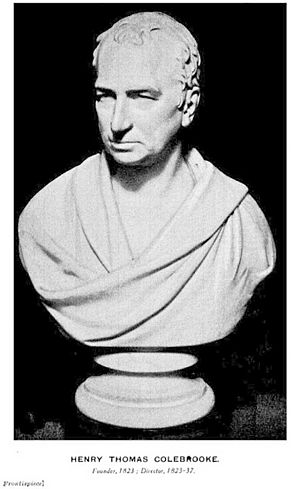James Heffernan (sculptor) facts for kids
James Heffernan (born 1788 – died 21 October 1847) was a talented Irish sculptor. He lived and worked mostly in London, England, during the late 1700s and early 1800s.
Life of James Heffernan
James Heffernan was born in Derry, Ireland, in 1788. His father was a marble-cutter and sculptor. He worked for Frederick Hervey, 4th Earl of Bristol, who was the Bishop of Derry at the time.
When James's father passed away in 1799, the Bishop helped James. He found him an apprenticeship with an architect named Michael Shanahan in Cork. Shanahan had a workshop where he made things from marble. James learned to create fireplaces and gravestones there.
In 1810, James left Ireland and moved to London, England. He studied at the Royal Academy Schools, which is a famous art school. He learned fine sculpture from two well-known artists, Charles Rossi and then Francis Chantrey.
James showed his sculptures at the Royal Academy from 1816 to 1830. He won the Royal Academy's silver medal for sculpture twice, in 1815 and 1817. After his studies, he traveled to Rome, Italy, to learn more about art.
When he returned, he worked for Francis Chantrey again. It seems that Chantrey often took credit for James's work. Many people believed that almost all the marble sculptures attributed to Chantrey were actually made by James. One person even said that James "cut in marble almost every one of Chantrey's busts literally from the first to the last."
James Heffernan only started getting full credit for his own work after Chantrey died in 1841. In 1843, James moved back to Cork, Ireland. Sadly, he died there on October 21, 1847, from dysentery. This was a difficult time in Ireland, with many people facing hardship.
Sculptures by Heffernan (often credited to Chantrey)
Francis Chantrey had a very busy workshop, and it was impossible for him to create every sculpture himself. Many people believe that James Heffernan made most of the marble sculptures from 1820 to 1841. Chantrey usually kept the "special projects," like sculptures of royalty, for himself.
Here are some works that are likely by James Heffernan:
- Dr John Hunter (1820)
- Sir Walter Scott (1820) at Abbotsford House
- Henry Colebrooke (1820) at the India Office
- Viscount Castlereagh (1821) at National Portrait Gallery, London
- George Canning (1821) at National Portrait Gallery, London
- William Wordsworth (1821)
- Charles Hutton (1822) at Newcastle Literary and Philosophical Society
- Lord Castlereagh (1822) at Windsor Castle
- Memorial to Dr Matthew Baillie (1823) in Westminster Abbey
- Granville Sharp (1824) at Guildhall, London (this was destroyed during World War II)
- Rev Cyril Jackson (1824) at Christ Church, Oxford
- Edward Daniel Clarke (1824) at Fitzwilliam Museum
- Sir Henry Halford (1825) at Royal College of Physicians
- George Canning (1826) in Chatsworth House
- Henry Cline (1827) in the Royal College of Surgeons
- Dean John Ireland (1829) at Bodleian Library Oxford
- Lewis Bagot (1829) at Christ Church, Oxford
- Sir Thomas William Coke (1829) at Holkham
- James Northcote (1831) at Pynes House, Norfolk
- Baron David Hume (1833) in Court of Session in Edinburgh
- John Abernethy (1833) in Royal College of Surgeons
- Mary Somerville (1837) at Royal Society of London
- Sir Jeffrey Wyatville (1837) at Windsor Castle
- Robert Southey (1837)
- Memorial to William Hazeldine (1840) working with John Carline at St Chad's Church, Shrewsbury
- Sir Stamford Raffles (date unknown) at Raffles Institution in Singapore
- Francis Cunningham (date unknown) in Scottish National Portrait Gallery
Other Works by Heffernan
James Heffernan also created many sculptures on his own. Here are some of them:
- Monument to Dr McCarthy in South Cork Parish Church (1808)
- Bust of J Stark (1818)
- Musidora (1822)
- Ino and Bacchus (1822)
- Memorial to William Bennet, Bishop of Cloyne (1823) in Cloyne Cathedral
- Miss E W Hill (1825)
- H P Briggs (1828)
- James Morrah (1832)
- Girl Caressing a Child (1832)
- Memorial to William Forrester in All Saints Church in Leicester (1832)
- Bust of James Watt (1834) now in the Royal Society of London
- Medallion of Sir Francis Chantrey (1842) in National Portrait Gallery of Scotland, Edinburgh
- Memorial to Francis Chantrey at his grave in Norton Parish Church near Sheffield (1842)


